
Mackerel is a common name applied to a number of different species of pelagic fish, mostly from the family Scombridae. They are found in both temperate and tropical seas, mostly living along the coast or offshore in the oceanic environment.
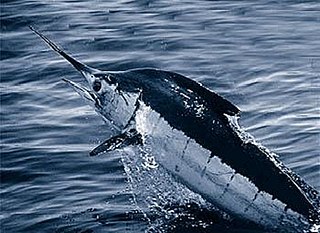
The term billfish refers to a group of predatory fish characterised by prominent bills, or rostra, and by their large size; some are longer than 4 m (13 ft). Billfish include sailfish and marlin, which make up the family Istiophoridae, and swordfish, sole member of the family Xiphiidae. They are apex predators which feed on a wide variety of smaller fish, crustaceans, and cephalopods. These two families are sometimes classified as belonging to the order Istiophoriformes, a group with origins in the Late Cretaceous around 71 million years ago with the two families diverging from one and another in the Late Miocene around 15 million years ago. However, they are also classified as being closely related to the mackerels and tuna within the suborder Scombroidei of the order Perciformes. However, the 5th edition of the Fishes of the World does recognise the Istiophoriformes as a valid order, albeit including the Sphyraenidae, the barracudas.

Rasbora is a genus of fish in the family Cyprinidae. They are native to freshwater habitats in South and Southeast Asia, as well as southeast China. A single species, R. gerlachi, is only known from an old specimen that reputedly originated from Africa (Cameroon), but this locality is considered doubtful. They are small, up to 17 cm (6.7 in) long, although most species do not surpass 10 cm (4 in) and many have a dark horizontal stripe.
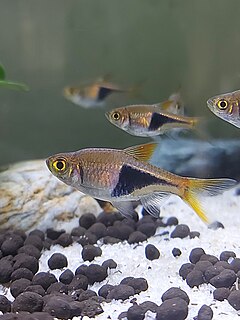
The harlequin rasbora is a small fish in the family Cyprinidae. The species became an instant favorite among aquarists after its introduction in the early 1900s and is the best known and most widely kept species among the rasboras. In 1935, an image of a trio of harlequin rasboras, stamped in 14k gold, would grace the cover of the first edition of William T. Innes's classic Exotic Aquarium Fishes and would remain so through all 19 editions.

The Caribbean sharpnose shark is a requiem shark, and part of the family Carcharhinidae.
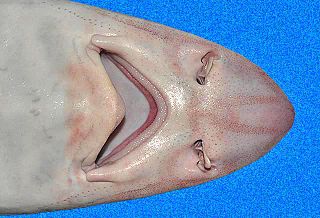
The narrowfin smooth-hound or Florida smooth-hound is a houndshark of the family Triakidae. It is found on the continental shelves of the subtropical western Atlantic, from Florida and the northern Gulf of Mexico to Venezuela, and also southern Brazil, between latitudes 32° N and 36° S, from the surface to a depth of 100 m. It can grow up to a length of 1.1 m.
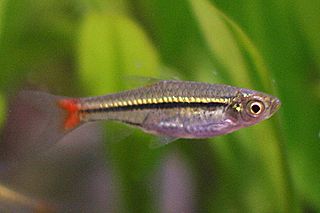
The blackline rasbora is a fish of the family Cyprinidae found in Asia in the Mekong, Chao Phraya, and Mae Klong basins, and also the northern Malay Peninsula. In the aquarium trade, it is known by a variety of other names, including red-tailed rasbora, bora bora rasbora, and brilliant rasbora.
Rasbora baliensis is a species of cyprinid fish in the genus Rasbora. It is found only on Bali in Indonesia where it is restricted to the crater lake, Lake Bratan, which sits at 1231m above sea level.

Rasbora tawarensis, locally known as depik, is a critically endangered species of cyprinid fish. It is endemic to Lake Laut Tawar in Indonesia, where its population is rapidly decreasing due to ecological disturbances, global warming, introduced species, unlawful fishing practices, and pollution.
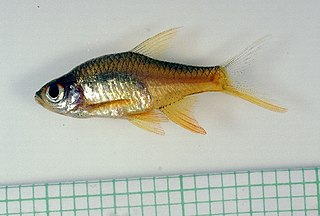
Rasboroides vaterifloris, known as the pearly rasbora, vateria flower rasbora or fire rasbora, is a species of freshwater cyprinid fish endemic to Sri Lanka. It can be found in the shallow waters of shaded, slow-flowing clear streams with a silt substrate. It also prefers areas with plentiful leaf debris. Its diet consists of detritus and terrestrial insects. This species can reach a length of 4 centimetres (1.6 in) TL. It can also be found in the aquarium trade.
Rasbora atridorsalis is a species of ray-finned fish in the genus Rasbora. It is found in the Mekong basin in Xishuangbanna and in Laos.
Rasbora ennealepis is a species of ray-finned fish in the genus Rasbora. It is endemic to Kalimantan, Indonesia.

Mindanao rasbora is a species of ray-finned fish in the genus Rasbora endemic to Mindanao.

The danionins are a group of small, minnow-type fish belonging to the family Cyprinidae. Members of this group are mostly in the genera Danio, Devario, and Rasbora. They are primarily native to the fresh waters of South and Southeast Asia, with fewer species in Africa. Many species are brightly coloured and are available as aquarium fish worldwide. Danio species tend to have horizontal stripes, rows of spots, or vertical bars, and often have long barbels. Devario species tend to have vertical or horizontal bars, and short, rudimentary barbels, if present at all. All danionins are egg scatterers, and breed in the rainy season in the wild. They are carnivores, living on insects and small crustaceans.

Red dwarf rasbora is a species of cyprinid found endemic to Lake Inle in Shan State in Myanmar. It belongs to the genus Microrasbora, which contains two small species of danionins.
Rasbora everetti is a species of ray-finned fish in the genus Rasbora. It is endemic to the Philippines.
Rasbora vulgaris is a species of ray-finned fish in the genus Rasbora. It is found on the Malay Peninsula.












